|
Curtiss N9H Floatplane
1/48 Scale Conversion
by
Michael Robinson
|
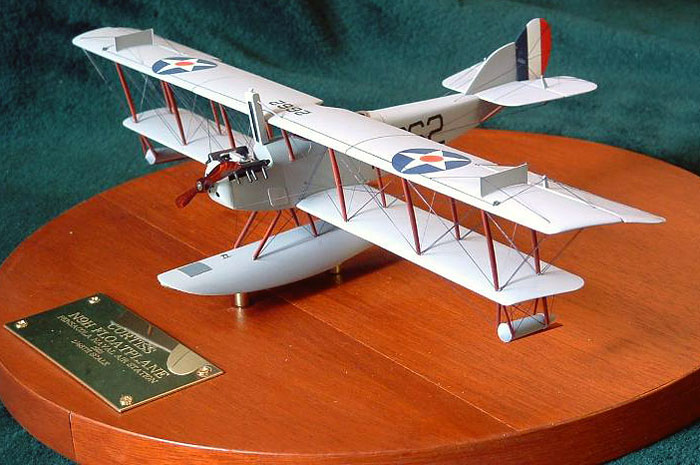
|
|
Curtiss N9H Floatplane |

HyperScale is proudly supported by
Squadron.com
I am a big fan of Pre World War 2 US Navy aviation,
and one of my favorite aircraft has always been the Curtiss Jenny.
Having grown up in Upstate New York, not far from where Glen Curtiss
developed his designs and grew his company, also helped foster that
interest.
When I read the original article in the July 1993
Fine Scale Modeler, of how Carl Park built his N9H, using three Lindberg
Jenny kits, I knew I had to do it. I made some minor deviations from his
article, in that I used only 2 Jenny kits and a Lindberg SE5 kit to
pirate the Hispano Suiza engine from. The only real reason he used 3
Jenny kits was to have an extra Stabilizer to cut the Ailerons from. I
chose to scratchbuild these instead.
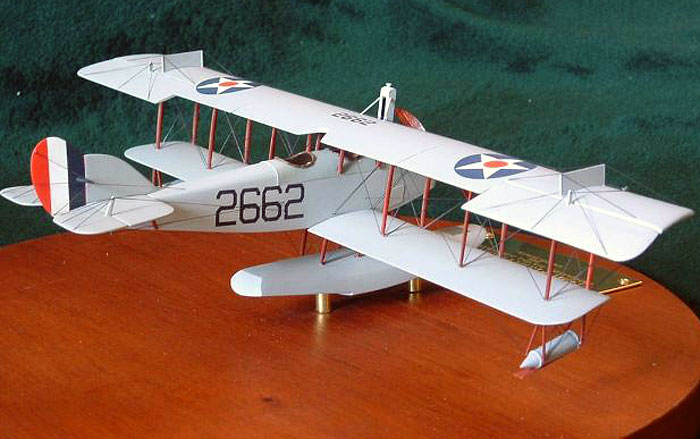
With his article in hand, a set of drawings
obtained from the Naval Aviation Museum in Pensacola, and photographs I
took of the N9H on display there, I began cutting plastic. In the
paragraphs below, I have outlined some of the techniques I used and the
work involved.
Fuselage
One kit’s fuselage
was used as the actual model, and the other was cut up to use as masters
to vacuform new coaming over the Cockpit, and a reshaped Turtle Deck
behind the Cockpit area.
The kit interior
walls were thinned considerably, by scraping with a cabinet scrapper to
approx. half the original thickness, for a more scale like appearance.
Interior Longerons and structure was added, along with internal bracing
wires. Control yokes, unique to the N9H were made from brass wire
soldered together, with control wheels from a spare PE Fret.
The Floor was made
from 1/64th plywood, as was the forward bulkhead and
Instructors Bulkhead. Rudder bars are fashioned from basswood strips,
with Rudder Fairleads attached as appropriate. The seats are made from
.010 plastic sheet with tape belts and PE Buckles.
The Cockpit is
accurate, with only the Instructors rear Cockpit having any flight
instruments. Students literally learned to fly by the seat of their
pants. The are of the cowl was heavily reshaped as the N9H has a much
different cowl, forward area, and side panels than the Jenny.
A New Nose was
vacuformed and installed, as well as a corrected Hispano-Suiza Engine
from a Lindberg SE5 kit. The engine was detailed with both Magnetos,
full ignition wiring, plumbing underneath for cooling lines (even though
you can’t see it, it’s there) scratchbuilt Intake Manifold and Carb, and
Exhaust pipes.
The prop is from
Copper State Models. All Cabane and Wing Struts are heavily modified kit
struts, jigged for accurate placement. The Radiator is scratchbuilt
using Evergreen Plastic Channel, Rod and Strip, and brass screen.
Control Lines were rigged using Lycra Thread.
|
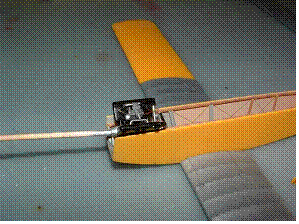
Fuselage under construction. Engine is being
test fitted in this picture. Note the different colors of plastic
wings from the two kits used. Interior structure is stained basswood
strips. |
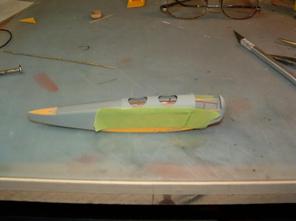
Fuselage under construction.
Vacuformed Cockpit cover and rear Turtle Deck have been
fitted, and interior components have been installed. New Nose has
been installed as well. |
Wings
This is where most
of the work was done.
N9H Wings are 10
feet longer in span than Jenny wings, so 2, 3-1/2 foot stubs were added
to the lower wings, and a 10 foot center section was added to the Top
Wing. Wings from both kits were sectioned and glued together. All rib
detail was sanded off as it was too intense, giving a “starved cow” look
to the wings. Actual fabric wings are drum taught, not sagging like many
kits portray it as. After the wings were sanded smooth, individual decal
strips were laid on using pencil guides where rib locations were. The
wings were squared up in a jig, then strut attachment holes were
drilled, as well as rigging attachment points.
The gaps in the
Upper wing are accurate. There was a 2-inch gap between the panels on
the actual aircraft. The rigging was done using Lycra Thread, stretched
from locating hole to locating hole and seized with a drop of CA. All
Rigging is accurate and functional, due to the length of the wings I
didn’t want them sagging. The real aircraft used doubled Flying wires,
and single Landing wires.
Ailerons were
fashioned from .005 sheet plastic with a .030 lead edge rod, embossed
from underneath for rib detail. The Skid fences on the Upper Wing are
also made from .010 plastic and .020 Rod. Pulleys for the Ailerons were
punched from .030 plastic using a homemade punch, and held in place by
fine wire brackets as the original.
A jig just for
this model was made to hold everything in alignment as each strut was
cut to fit and glued in place. Wing Bay Bracing Wires were set into the
strut holes before the strut was glued in place.
|
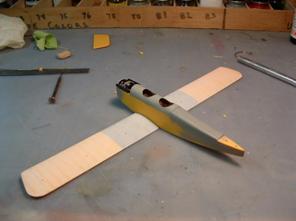
Wings fitted and a dust coat of primer sprayed
on wings before sanding off the overly done ribs. |
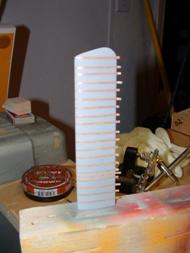
Tedium on display. Individual strips of decal
strips being layed on the wings, following pencil marks indicating
Rib Stations. These were then overspraed with Primer again, then
painted. |
|
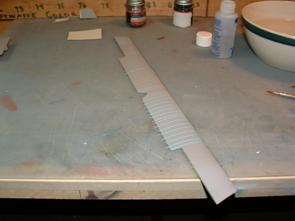
Upper Wing being taped. That sucker is almost
13 inches long. The N9H was somewhat underpowered, and needed a
longer span to generate enough lift to break free of the water
suction on the bottom of the float |
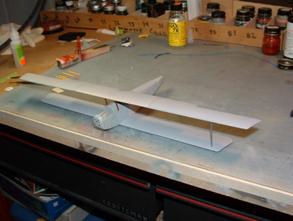
First trial fit of the upper wing to the Cabane
Struts. |
Tail Surfaces
The Fin on the N9H is “humpier” in
profile, so a new Fin was made using .030 sheet. Kit Rudder was used,
after sanding down trail edges and fixing outline of Rudder. Kit
Stabilizers and Elevators were used, with the same sanding of trail
edges. Control Horns are made from .020 plastic to replace the overly
thick kit items.
|

All major airframe work has been done at this
point. It’s starting to look like an airplane. Note the new Fin, cut
from the left over kit’s Stabilizer. |
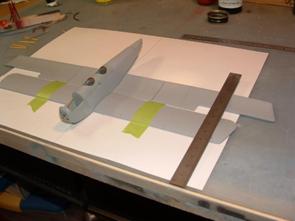
Major Blonde Moment during construction. When
laying out the strut location hole I used tape to hold model firm to
layout sheet. Guess what else came off when I pulled the tape up?
Yep… you guessed it. 4 rib tapes per wing. Duh. |
|
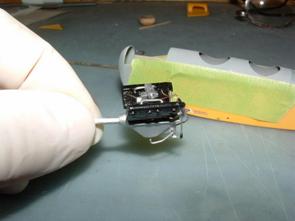
The completed Engine. Scratchbuilt Intake and
Carb, all coolant and oil lines present. |
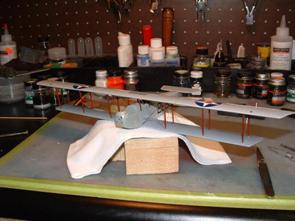
The Model after removing the jig fixture.
Struts have been installed and Rigging is starting. |
Floats
Main Center Float was carved from Basswood,
sealed, sanded and painted, then holes located and drilled for Strut
attachment. Rigging wire points were also drilled. Wing Tip Floats are
turned ¼ inch dowel, with .005 strip wrapped around for joint lines.
Struts for floats were made from .020 plastic, sanded to correct shape
and profile, with brass pins in the end for mounting strength. 1200 grit
wet/dry sandpaper makes nice anti-skid areas, and brass wire was formed
and soldered together for the Cleat on the Main Float.
|

Inside this scrap basswood there is a Main
Float… |
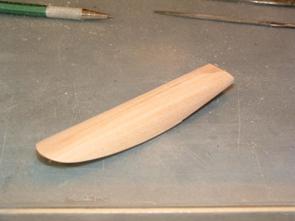
See? There it is, after about an hour’s worth
of carving and sanding. |

Paint is Duplicolor Sandable Primer. It’s as
close to Navy Gray for that era as you will find, and being lacquer
based sprays easily. After painting the model was sealed with Future
prior to using various decals from the scrap box to represent one of
hundreds of N9H’s delivered to the Navy. A final overcoat of Dullcoat to
scale down the gloss and the model was finished.
The base is ½” Particle Board with Mahogany
Veneer, stained and sealed, with Brass Rod used to attach model to base.
Click the thumbnails below to view larger images
Model, Images and Text Copyright ©
2003 by Michael Robinson
Page Created 07 November, 2003
Last Updated 17 March, 2004
Back to HyperScale
Main Page
|
Home |
What's New |
Features |
Gallery |
Reviews |
Reference |
Forum |
Search